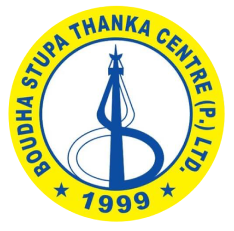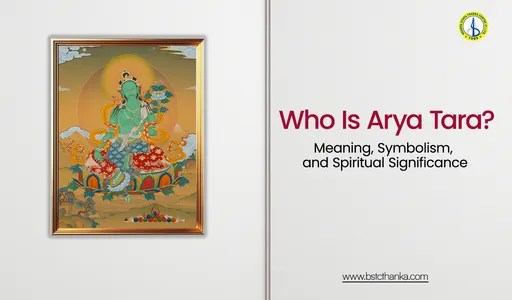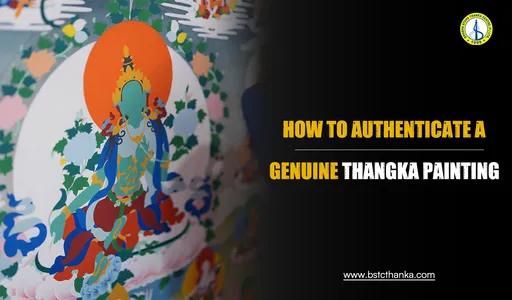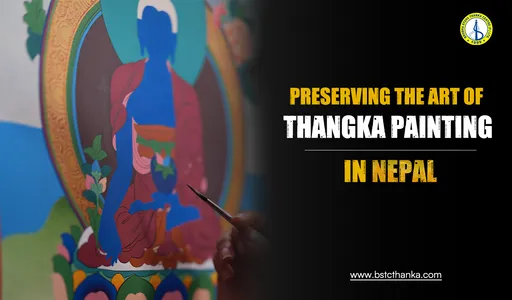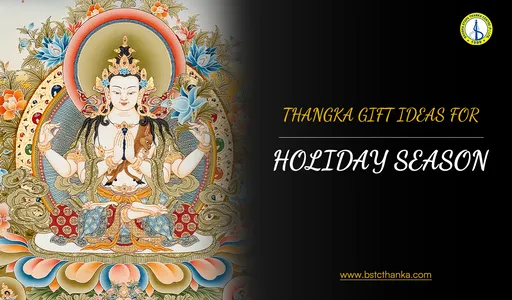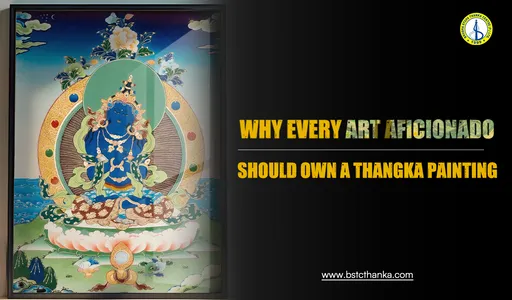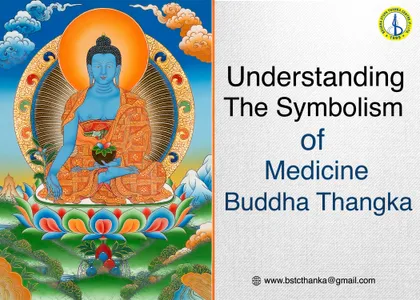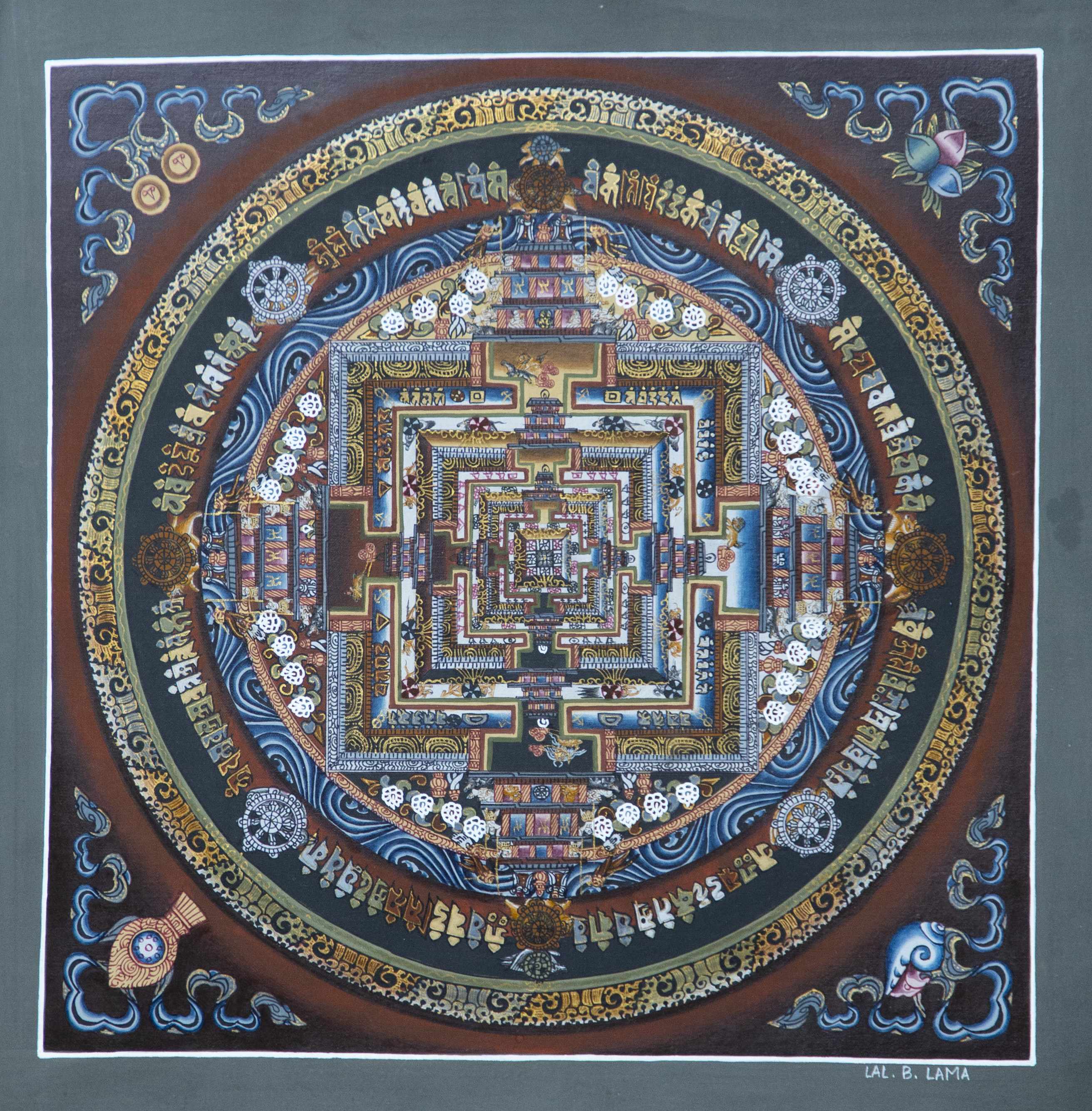
Types of Thangka Paintings : Sacred Tibetan Art
Thangka Painting Overview
Thangka paintings are traditional Tibetan artworks that depicts various Buddhist deities like Mahakala, Tara, wrathful deity Vajrapani, peaceful deity Zambala, goddess of mercy Tara, and more. Thangka paintings are handcrafted on pure cotton and silk canvas decorated in Silk brocade. These paintings serve as visual aids for meditation and religious rituals, conveying deep spiritual symbolism. The thangka paintings are also used as decoration pieces in living spaces and homes.
To create a Traditional Thangka art artists use natural mineral colors (white clay, red clay, southern alkali, cinnabar, indigo stone, borax, cold water stone, copper ore etc), gold for purity, and flowers.
Types of Thangka Painting
Thangka paintings can be seen in different types, Karma Gadri style (mostly seen in Japanese deity thangka), Newari style (Own style of Newar community of Nepal), Tibetan thangka (has traditional rules and styles). Every tradition and culture has their own style of crafting thangka painting. The 5 types of thangka paintings are:
- Newari thangka
- Tibetan thangka
- Karma Gadri thangka
- Ngor thangka
- Mandala thangka
Newari Thangka
Newari thangka paintings are also known as Paubha, traditional artworks from the Newari community of Nepal. These paintings are renowned for their intricate details, vibrant colors, and spiritual significance. Depiction of hindu deities (Ganesha, Shiva), Buddhist deities, mandala, and scenes from religious texts. Newari Thangka paintings are known for their vibrant colors and religious significance.
Tibetan thangka
Tibetan Thangka is a sacred artwork depicting Buddhist deities, Mandala, and religious scenes of Buddhist teachings, scriptures or stories on pure cotton or silk canvas. The writing of Tibetan thangka follows strict religious and artistic rules. Similar to other thangka Tibetan thangkas are used as an aid for meditation and tantric practice. Each element used in the thangka paintings, from colors to symbols, holds specific meanings, reflecting the artist's deep knowledge of Buddhist teachings. The process is considered meditative practice, with each step performed with mindfulness and reverence.
Karma Gadri thangka
The Karma Gadri style of Thangka painting originated from the 8th Karmapa, Mikyö Dorje, in the 16th century. This style is known for its unique blend of Tibetan, Chinese, and Indian influences.
Key features of Karma Gadri style Thangka paintings include:
Proportions and Forms: Based on Indian canons.
Landscape and Composition: Derived from Tibetan traditions.
Techniques: Incorporate Chinese shading, colors, and textures.
Unlike the more ornate styles, Karma Gadri emphasizes simplicity and clarity, with a focus on the harmony between the figures and their natural surroundings. This style of thangka arts are often seen in Japanese deity thangka paintings.
Ngor thangka
Ngor thangka is a style associated with the Sakya school of Tibetan Buddhism, particularly linked to the Ngor monastery, founded in the 15th century by the master Ngorchen Kunga Zangpo. The compositions are often dense, featuring elaborate mandalas, deities, and protector figures, all meticulously rendered with precise iconography.
One of the defining features of Ngor thangkas is the use of rich, saturated colors, with a strong emphasis on reds, blues, and gold. The backgrounds are often adorned with intricate floral or geometric patterns, adding to the overall complexity of the artwork. Figures are depicted with rounded faces and delicate features, and the deities are often surrounded by ornate halos and thrones.
Examples of Ngor thangkas include depictions of the Hevajra mandala, a central icon in the Sakya tradition, and thangkas of deities like Vajrayogini and Manjushri, which are revered within the Ngor lineage.
Mandala thangka
Mandala Thangka paintings are intricate, geometric designs symbolizing the universe. Mandala thangkas are also used as meditation aids in Buddhist practice. These thangkas feature circular, geometric patterns with a central deity or sacred symbol, surrounded by concentric designs that represent various aspects of the cosmos or spiritual realms. The creation of Mandala thangka follows precise measurements and symmetrical being crucial. The mandala's design is meant to guide the viewer through a spiritual journey, leading toward enlightenment and inner peace.
Types of Thangka Painting Based on Technique
Thangkas can be categorized based on techniques used while writing thangka paintings. These traditional techniques of crafting thangka paintings are Palas, Dras-drub-ma (Applique thangka), and Dpar Ma (Block thangka). The types of thangka painting based on techniques are:
Palas
“Palas technique” involves the use of natural pigments, often derived from minerals and plants, to create vibrant and long-lasting colors. The process begins with preparing the canvas, usually made of cotton or silk, which is then coated with a mixture of chalk and animal glue to create a smooth surface. Artists meticulously outline the design before applying colors in layers, ensuring precision and detail.
Dras-drub-ma/ Applique Thangka
Appliqué thangkas are a unique form of Tibetan Buddhist art, crafted using fabric rather than traditional painting. These thangkas are created by stitching together pieces of silk, brocade, and other textiles to form intricate images of deities, mandalas, or religious scenes. The appliqué technique allows for a three-dimensional effect, with raised elements adding depth and texture to the artwork. These thangkas are often large and highly detailed, requiring meticulous craftsmanship.
Dpar Ma/ Block Thangka
"Dpar Ma" thangkas are a specific type of Tibetan Buddhist artwork that is characterized by its use of woodblock printing techniques. Unlike traditional hand-painted thangkas, Dpar Ma thangkas are created by carving detailed images onto wooden blocks, which are then inked and pressed onto cloth or paper to create the final image. These thangkas often feature intricate line work and are sometimes hand-colored after printing to enhance their appearance.
Types of Thangka Based on Background Color
Colors have significant meaning in thangka paintings; each carefully inked colors carry its own meaning. Red color signifies power and the transformation of passion into wisdom, blue color represents the infinite and vastness of space, yellow color symbolizes the earth, green represents nature and balance, while white color stands for purity, peace, and the absence of suffering in thangka.
Different colors used in the background of thangka painting have ritual meanings. Golden thangka, black thangka, red thangka, and multicolored thangka are often seen in the domain of thangka.
Golden Thangka
Golden thangkas, or ser thangkas, represent the highest level of craftsmanship and spiritual significance in Tibetan art. They are created using gold leaf or gold paint, which symbolizes enlightenment, purity, and the divine nature of the deities depicted. The use of gold is not only a sign of reverence but also enhances the thangka's luminosity, making it appear radiant and sacred.
Black Thangka
Black thangkas, or "Nag-thang," are a unique form of Tibetan Buddhist art. These thangkas are usually painted on a black background, with figures and symbols highlighted in gold or bright colors. They often depict wrathful deities or protectors, symbolizing the transformation of negative energies and the removal of obstacles on the path to enlightenment. The dark background represents emptiness or the void, a key concept in Buddhism. These thangkas are used in meditation practices to aid in the visualization of deities, helping practitioners cultivate inner strength and overcome fears.
Red Thangka
A red background in thangka painting often symbolizes the deity’s body hue and represents power, transformation, and wrath. The color red is associated with the fire element, representing purification and the burning away of obstacles. Used in meditation and ritual practices, red thangkas aid practitioners in visualizing deities, fostering strength and courage.
Types of Thangka Painting Based on Depiction
Thangka painting is the depiction of Buddhist deities. Based on depiction, wrathful deities thangka, peaceful deities thangka, Mahakala thangka, Buddha thangka, Tara thangka, Kagyu thangka, and Japanese deity thangkas are famous.
Wrathful Deities Thangka
Wrathful deities of Buddhism depicted in wrathful deity thangka paintings are fierce deities often wearing skull crowns, angry eyes, and have terrifying personalities. Though they appear terrifying, these deities are not malevolent but embody compassion and serve as protectors of the Dharma, guiding practitioners towards enlightenment. Some of the wrathful deities in Buddhism are Vajrapani, Vajrakilaya, Chakrasambhara, Vajrayogini, Sinhamukh, Kalachakra deity, He Vajra, Rahula.
Peaceful Deities Thangka
Peaceful deities in Buddhism are the symbolic representation of compassion, love, wisdom, and insight. The peaceful deities are depicted in traditional Tibetan thangka paintings. The peaceful deities depicted in peaceful deity thangka paintings are Zambala, Saraswati, Chenrezig, Dorje Sempa, Manjushree, Kisitigarbha.
Mahakala Thangka
On the basis of depiction, in Mahakala thangka, Mahakala is revered as a powerful protector of the Dharma. Mahakala is often depicted with a fierce expression, dark blue or black skin, and adorned with skulls in traditional Tibetan Mahakala thangka. Mahakala embodies the energy needed to eliminate obstacles and negative forces.
Buddha Thangka
Buddha thangka is a traditional Tibetan painting depicting the Buddha, often illustrating various aspects of his life, teachings, or symbolic postures (mudras). These thangkas are used for meditation, rituals, and as a visual guide for spiritual practice. A Buddha thangka is not just art but a sacred aid for spiritual connection and reflection in Tibetan Buddhism for practitioners.
Tara Thangka
Another type of thangka in Tiibetan tradition based on depiction of Buddhist deities is Tara thangka paintings. In Tara thangka paintings, Tara is depicted in 4 main forms; Green Tara thangka, Red Tara, White Tara and Yellow Tara. Each aspect of Tara's imagery, from her posture to her hand gestures (mudras), carries deep symbolic meaning, reflecting her role as a guide to enlightenment.
Kagyu Thangka
Kagyu thangka paintings feature the important figures and teachings of the Kagyu lineage. The Kagyu thangka represents figures like Marpa, Milarepa, or Gampopa, surrounded by other lineage masters and symbolic imagery. Tibetan siddha Milarepa and Karmapa are depicted in Kagyu thangka paintings.



